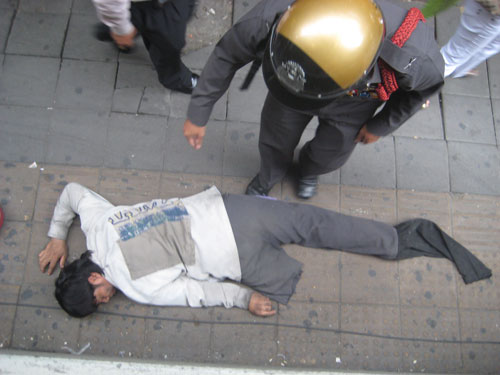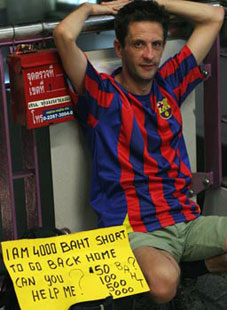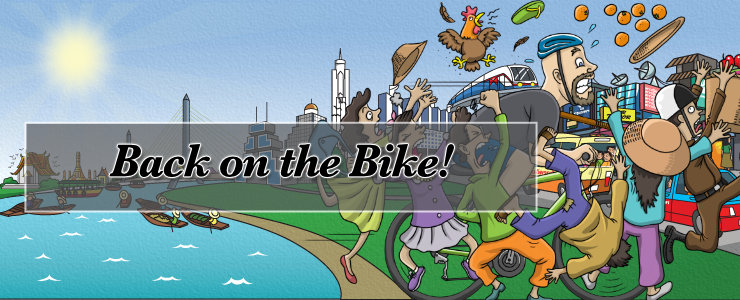Now, before I start this off, let me say that I don’t have anything against those less fortunate than us. I’ve spent more than my fair share of time taking HIV-positive kids on field trips, painting orphanage walls with mentally challenged teenagers and volunteer teaching at schools for underprivileged children. But in Thailand – especially Bangkok – being a just and noble contributor to the plight of the poor is often harder than it seems. Bangkok’s streets are full of beggars – women with babies, leper-ridden octogenarians, deformed outcasts and pitiful looking children – all holding up a cup and asking for a spare coin or two. I’m going to sound like a complete ass for saying this, but I never give. Well, I rarely give. You see, it’s often hard to spot the real beggars from the fake ones, and even the real ones are often working as part of a syndicate. It’s not easy to hear, but the harsh truth is that you may actually be doing them a favor by ignoring them. So how can you spot a person in genuine need vs a person who’s just milking his sympathy card for all it’s worth? Well, it’s not a science, but a bit of education will often go a long way.
First and foremost, the following is simply my personal take on the matter based on what I’ve read, heard and seen, and is by no means the gold standard of truth; there will always be an exception to every rule, especially one as touchy as this. If you see someone who has no arms, or whose spine is horribly deformed, or who has cancerous lesions on their face – it’s a pretty safe bet that a small donation will do a hell of a lot more good for them that it will for you.
However, the women with babies in their laps that sit on the steps of the skytrain stations – most of the time, those babies aren’t theirs. They’re often ‘owned’ by a group of people who pass them around to different women on different days, depending on need, location, availability, etc. These types of arrangements are the most common and take place throughout Asia, with the ‘beggar master’ (a term taken from Rohinton Mistry’s devastating book A Fine Balance) usually taking the lion’s share, and giving the actual beggar just enough to live on.
Another scam that has emerged as a serious problem is begging monks, both male and female. The first thing you need to know is that, according to a monk’s monastic vows, called the Patimokkha (specifically, the Nissaggiya Pacittiya, precept 18), owning money, precious metals or jewels is forbidden. If you’re up early enough in most Buddhist countries (around 5.30 – 6 am), you will likely see dozens of lone monks, walking around, each with a large alms bowl, into which laypeople place food in return for a blessing. This is not begging – this is how monks get their food and basic necessities, and it’s how ‘karma points’ (for lack of a better term) are earned and distributed; give food to the holy man, and you look pretty good in God’s eyes. Some guy standing in place with a bowl out? He’s not a monk.
It’s also good to use a bit of common sense. The other day, a woman holding a naked child approached my tuk-tuk and held out her hand. She was obviously homeless, but I didn’t give her any money. Why? Well, the kid she was holding was about 10, and clothes are easy to find and super-cheap; if it was any kind of a priority at all, the kid would have pants on. Also, I noticed that she had blonde highlights in her hair. Let me tell you – if I’m genuinely homeless and trying to feed and clothe my naked 10-year old, a trip to the hair salon is going to be pretty low on my list of priorities.
And last but not least, two ‘regulars’ along the Bangkok streets who piss me off. First, this guy below, who has a leg missing below his thigh, and perhaps his right foot (although sometimes they tuck it inside, hence the long trouser leg:

Now, I’m not saying that his life is easy by any stretch of the imagination, but people with one leg have climbed Everest, downhill skied, managed companies and done a hell of a lot more. Surely there has to be something between running a marathon and laying on your stomach in the very middle of one of the busiest streets in Bangkok. I may seem harsh, but to me, this guy is just milking his disability for all it’s worth. Apparently, the policeman agreed with me, as he told the guy to get up and move along just as I took the picture.
And last but not least, one of the biggest jerkwads in Bangkok, the Farang Beggar, seen here:

“No, I don’t have any friends back home that can help. I’m a total douche.”
This guy has been seen multiple times all over the city by anyone who has lived here more than six months; the always entertaining Lost Boy wrote about him 2 years ago here. He has absolutely no shame in begging and has even done an interview where he states he makes about 30,000 baht per month (more than many Thais make). I watched him for about 30 minutes one time at Siam Square, and estimated that he made around 300 baht by “awww, shucks’ students walking by. Six hundred baht ($16) an hour – not bad for sitting on your ass.
So – if you’re feeling generous and want to give, by all means, spread the wealth to your heart’s content! But be aware of who you’re giving to – your donation might go further if you give to a registered charity organization





Perfectly true posting. The real beggars you can tell fairly easily, at my place it is a couple of guys living seperately, day time they beg for a few hours night time they are sleeping on a piece of cardboard near the same location – 2 of these guys are clearly mentally dissarranged.
The other time it is easy to tell a real beggar is old people in Thai areas – these I give some money to. Beggars who travel in BMW’s to work in Sukhumvit (and other tourist areas) are not worth giving cash to.
The fake monks are another problem, I now follow these idiots telling all and sundry that they are fake – this pisses them off to no end. I got this trick from Stickmans website. Real Buddhist monks don’t get angry and swear at you.
I’m another who doesn’t give to beggars. Mostly.
There’s one old guy in Ari who is clearly a local. And him, I do give to on occasion.
The rest I walk around.
About the blonde highlights… I saw some kids in Cambodia with these streaks and had the same reaction… until someone told me that it was probably due to malnutrition. Eek. Not sure if it’s true, but thought I’d mention it!
Funny enough a lot and I mean a lot of the kids you see out there being used by the begger groups are not even Thai more often than not they are Cambodian. The only sort of begger I ever give to is the lady on the walk over Petchaburi Rd by Pantip Plaza, at least she has a cheap scale and offers to let you weigh yourself for you donation.. ok it’s kinda lame but at least it’s an effort.. amazing that in this day and age some people didn’t know how fake so many of these people are.. Google is a wonderful thing folks..
I know just the lady you’re talking about Jack, although I’m scared to use her scale because I might break it. 🙂 What I hate most is perfectly able-bodied men just standing there asking for change. When I was in New Delhi, a girl of about 12 was doing CRAZY gymnastic/yoga poses on the side of the road for change. If I wasn’t whizzing by in a car I would have given her a lot.
Yeah I hear ya, one time I bought her a new scaled because the old one looked ready to fall apart.. I do hope you are meaning that and not that your ummmmm girth would cause issues hahaha..
I really love when people make the effort. If you are ever driving on Rama 9 road just before the Ekammai intersection there is a guy there with ONE leg selling lillies… he charges a bit too much for them, but my wife and I always grab some and he each and every time gives us a little info about how to best care for them, etc… ONE LEG and hobbles around there all night selling those flowers.. when I see that and I think of that stupid farang begging for airfare I just want to kick him in the…… well you know.. 🙂 ummm I mean kick the farang of course haha
Don't give them money. Give them food instead..if you really feel like giving.
Begging monks have even made it to the great white north too.
http://www.edmontonjournal.com/news/edmonton/dressed+monks+monetary+donations+downtown+Edmonton+aren/11299541/story.html
Ugh. I’d say the average Canadian is totally unaware of how Buddhism works. These guys are pure scammers.